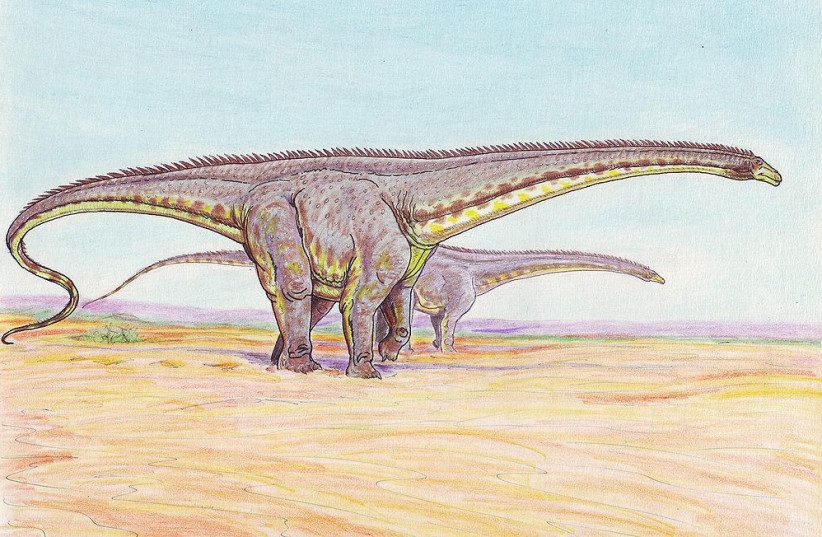A new study refuted the previously held belief that the diplodocids, the long-necked and long-tailed sauropod dinosaurs like the Brontosaurs, defended themselves by whipping their tail faster than the speed of sound.
According to some scientists, the diplodocids would whip their tail faster than the speed of sound as a way of defense – but that likely isn't actually true.
A new study has now called this prior assumption into question, and the findings were published in the peer-reviewed academic journal Scientific Reports.
Dinosaurs and the speed of sound: Waving your tail like you just don't care about physics
Diplodocid sauropods were absolutely enormous dinosaurs, with the famous Brontosaurus being one of the most well-known.

These gigantic herbivores could sometimes stretch to around 42 meters long, with their long necks and tails considerably adding to their size.
But their necks weren't exactly the best. Indeed, it seems that, unlike other sauropods, these dinosaurs couldn't exactly lift their necks up high to eat from trees, so they likely instead ate plants from other areas.
Rather than their necks, what may be the most fascinating part of diplodocid dinosaurs are their tails.
These long tails have entranced scientists for years, especially as more information about their structure has been gleaned from other evidence – this is important since no actual complete diplodocid tail has ever been found.
With all the information that is known, scientists had run computer models and simulations to better see how these dinosaur tails may have worked.
Eventually, one commonly cited theory was that this long tail was ideal for snapping back and forth quickly and had a soft tip at the end of the tail that would extend it by a meter. Indeed, this ability was shown in a 1997 study to allow the dinosaurs to whip their tails so fast that this tip of the tail, known as the "popper," would have shattered the sound barrier by reaching speeds of around 560 meters per second (the speed of sound is 343 meters per second).
This bullwhip-like tail waving would have been so fast that it would have released a sonic boom louder than 200 decibels. For context, the sheer volume of this sound would have been louder than thunder, which is 120 decibels, or a fighter jet taking off, which is 130 decibels.
The average human being can only experience 110 decibels before it starts to harm the body in some way. In fact, sounds above 150 decibels can make eardrums burst, and sounds around the 185-200 decibel mark can even kill a person.
With a tail whip that fast, a diplodocid dinosaur could likely cause serious damage as the sound of the whip reverberates for miles. So what did they use it for?
Some scientists speculated that they were used for defense against predators or maybe even against other diplodocids. Others speculated that it was entirely for mating purposes, with the sound being used to attract other diplodocid dinosaur mates as part of sexual selection.
And that would all be fine, if it were possible, with a new study arguing that the tail would not have been able to function like this at all.
To reach this conclusion, the researchers behind the study, led by Simone Conti, decided to try out a new model and simulation, based on information from five different fossilized diplodocid dinosaurs.
With all these values imputed, the tail was ultimately over 12 meters, consisted of 82 vertebrae and weighing over one and a half tones (1,446 kilograms).
What they found was that yes, this tail could move pretty fast when whipped, around 33 meters per second. To put that speed into perspective, that's faster than the average speed of a cheetah, the fastest land animal currently alive, and is also around the speed of a hurricane, according to the US National Hurricane Center.
But it is also 10 times slower than the speed of sound.
But what about the popper on the tail? Does that make a difference?
To figure this out, the researchers decided to test out different possible tips that would be at the end of the tail. However, none of them were able to do so. Rather, the tail likely wouldn't have been able to survive going supersonic speeds without getting severely damaged. It is also still unclear if the popper even existed, though the study doesn't rule it out.
That doesn't mean the tails were useless, however.
Swinging a massive and heavy tail like what these dinosaurs had at a speed of around 100 kilometers an hour was certainly no simple matter. It wouldn't have broken bones or lacerated skin – which makes sense since the force the tail would give while whipping would also apply to the tail itself – but it still would have been painful. It is certainly feasible that these tails could have been swung as a defensive weapon against predators, or even in combat with other diplodocid dinosaurs.
An earlier study from 2020 that also predicted that these tails would not be able to be moved at supersonic speeds had another use in mind as well.
According to that study, the tail would likely have been used to touch other dinosaurs, especially while migrating. The idea is rather than weapons, these diplodocid tails may have been used for social communication between dinosaurs.
However, Conti's study doesn't draw conclusions on this point, mentioning that it is possible but lacks any supporting evidence.
Perhaps finding a complete diplodocid dinosaur tail fossil could answer these questions.
